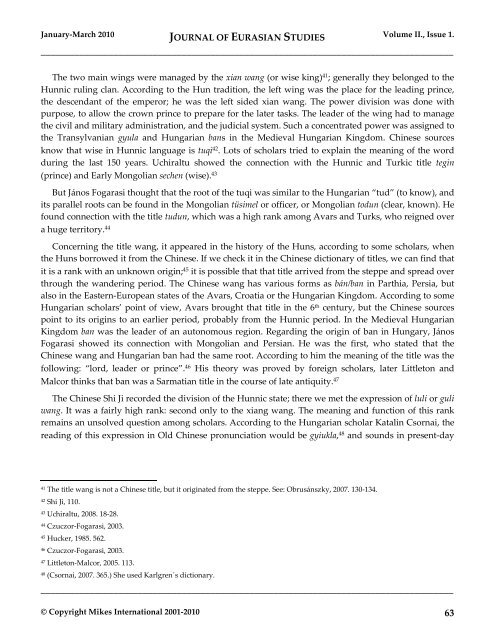EurasianStudies_0110..
EurasianStudies_0110..
EurasianStudies_0110..
Create successful ePaper yourself
Turn your PDF publications into a flip-book with our unique Google optimized e-Paper software.
January-March 2010 JOURNAL OF EURASIAN STUDIES Volume II., Issue 1.<br />
_____________________________________________________________________________________<br />
The two main wings were managed by the xian wang (or wise king) 41 ; generally they belonged to the<br />
Hunnic ruling clan. According to the Hun tradition, the left wing was the place for the leading prince,<br />
the descendant of the emperor; he was the left sided xian wang. The power division was done with<br />
purpose, to allow the crown prince to prepare for the later tasks. The leader of the wing had to manage<br />
the civil and military administration, and the judicial system. Such a concentrated power was assigned to<br />
the Transylvanian gyula and Hungarian bans in the Medieval Hungarian Kingdom. Chinese sources<br />
know that wise in Hunnic language is tuqi 42 . Lots of scholars tried to explain the meaning of the word<br />
during the last 150 years. Uchiraltu showed the connection with the Hunnic and Turkic title tegin<br />
(prince) and Early Mongolian sechen (wise). 43<br />
But János Fogarasi thought that the root of the tuqi was similar to the Hungarian “tud” (to know), and<br />
its parallel roots can be found in the Mongolian tüsimel or officer, or Mongolian todun (clear, known). He<br />
found connection with the title tudun, which was a high rank among Avars and Turks, who reigned over<br />
a huge territory. 44<br />
Concerning the title wang, it appeared in the history of the Huns, according to some scholars, when<br />
the Huns borrowed it from the Chinese. If we check it in the Chinese dictionary of titles, we can find that<br />
it is a rank with an unknown origin; 45 it is possible that that title arrived from the steppe and spread over<br />
through the wandering period. The Chinese wang has various forms as bán/ban in Parthia, Persia, but<br />
also in the Eastern-European states of the Avars, Croatia or the Hungarian Kingdom. According to some<br />
Hungarian scholars’ point of view, Avars brought that title in the 6 th century, but the Chinese sources<br />
point to its origins to an earlier period, probably from the Hunnic period. In the Medieval Hungarian<br />
Kingdom ban was the leader of an autonomous region. Regarding the origin of ban in Hungary, János<br />
Fogarasi showed its connection with Mongolian and Persian. He was the first, who stated that the<br />
Chinese wang and Hungarian ban had the same root. According to him the meaning of the title was the<br />
following: “lord, leader or prince”. 46 His theory was proved by foreign scholars, later Littleton and<br />
Malcor thinks that ban was a Sarmatian title in the course of late antiquity. 47<br />
The Chinese Shi Ji recorded the division of the Hunnic state; there we met the expression of luli or guli<br />
wang. It was a fairly high rank: second only to the xiang wang. The meaning and function of this rank<br />
remains an unsolved question among scholars. According to the Hungarian scholar Katalin Csornai, the<br />
reading of this expression in Old Chinese pronunciation would be gyiukla, 48 and sounds in present-day<br />
41 The title wang is not a Chinese title, but it originated from the steppe. See: Obrusánszky, 2007. 130-134.<br />
42 Shi Ji, 110.<br />
43 Uchiraltu, 2008. 18-28.<br />
44 Czuczor-Fogarasi, 2003.<br />
45 Hucker, 1985. 562.<br />
46 Czuczor-Fogarasi, 2003.<br />
47 Littleton-Malcor, 2005. 113.<br />
48 (Csornai, 2007. 365.) She used Karlgren´s dictionary.<br />
_____________________________________________________________________________________<br />
© Copyright Mikes International 2001-2010 63

















